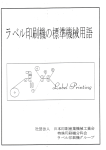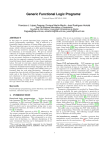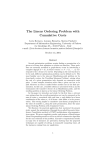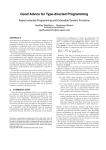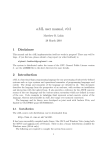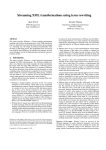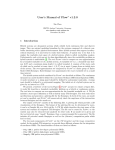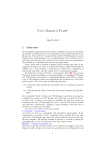Download Ambivalent Types for Principal Type Inference with - Gallium
Transcript
Ambivalent Types for
Principal Type Inference with GADTs
Jacques Garrigue1 and Didier Rémy2
1
Nagoya University, Graduate School of Mathematics
2 INRIA, Rocquencourt?
Abstract. GADTs, short for Generalized Algebraic DataTypes, which allow constructors of algebraic datatypes to be non-surjective, have many useful applications. However, pattern matching on GADTs introduces local type equality assumptions, which are a source of ambiguities that may destroy principal types—
and must be resolved by type annotations. We introduce ambivalent types to
tighten the definition of ambiguities and better confine them, so that type inference
has principal types, remains monotonic, and requires fewer type annotations.
1
Introduction
GADTs, short for Generalized Algebraic DataTypes, extend usual algebraic datatypes
with a form of dependent typing by enabling type refinements in pattern-matching
branches [2,14,1]. They can express many useful invariants of data-structures, provide
safer typing, and allow for more polymorphism [11]. They have already been available
in some Haskell implementations (in particular GHC) for many years and now appear
as a natural addition to strongly typed functional programming languages.
However, this addition is by no means trivial. In their presence, full type inference seems undecidable in general, even in the restricted setting of ML-style polymorphism [10]. Moreover, many well-typed programs lack a most general type. Using explicit type annotations solves both problems. Unfortunately, while it is relatively easy to
design a sound typing algorithm for a language with GADTs, it is surprisingly difficult
to keep principal types without requesting full type annotations on every case analysis.
Repeatedly writing full type annotations being cumbersome, a first approach to a
stronger type inference algorithm is to propagate annotations. This comes from the
basic remark that, in many cases, the type of a function contains enough information to
determine the type of its inner case analyses. A simple way to do this is to use program
transformations, pushing type annotations inside the body of expressions.
Stratified type inference for GADTs [9] goes further in that direction, converting
from an external language where type annotations are optional to an internal language
where the scrutinee of case analysis and all coercions between equivalent types must be
annotated. This conversion is an elaboration phase that collects all typing information
—not only type annotations— and propagates it where it is needed. The internal language allows for straightforward type inference and it has the principal type property.
?
Part of this work has been done at IRILL.
2
Jacques Garrigue and Didier Rémy
It also enjoys monotonicity: strengthening the type of a free variable by making it more
general preserves well-typedness. As expected, principality does not hold in general in
the external type system (a program may be typable but have no principal type), but it
does hold if we restrict ourselves to those programs whose elaboration in the internal
language is typable. However, since elaboration extracts information from the typing
context, monotonicity is lost: strengthening the type of a free variable by making it
more general before elaboration can reduce the amount of type information available
on the elaborated program and make it ill-typed. Monotonicity is a property that has
often been underestimated, because it usually (but not always) holds in languages with
principal types. However, losing monotonicity can be worse for the programmer than
losing principal types. It reveals a lack of modularity in the language, since some simple
program transformations such as simplifying the body of a function may end up inferring more general types, which may subsequently break type inference. Propagating
only type annotations would preserve monotonicity, but it is much weaker.
GHC 7 follows a similar strategy, called OutsideIn [13], using constraint solving
rather than elaboration to extract all typing information from the outer context. As a result, propagation and inference are interleaved. That is, the typing information obtained
by solving constraints on the outer context enclosing a GADT case analysis is directly
used to determine the types of both the scrutinee and the result in this case analysis.
Type inference can then be performed in the body of the case analysis. By allowing
information to flow only from the outside to the inside, principality is preserved when
inference succeeds. Yet, as for stratified type inference [9], it lacks monotonicity.
While previous approaches have mostly attempted to propagate types to GADT case
analyses, we aim in the opposite direction at reducing the need for type information
in case analysis. This aspect is orthogonal to propagation and improving either one
improves type inference as a whole. Actually, OutsideIn already goes one step in that
direction, by allowing type information to flow out of a pattern-matching case when no
type equation was added. But it stops there, because if type equations were added, they
could have been used and consequently the type of the branch is flagged ambiguous.
This led us to focus our attention on the definition of ambiguity. Type equations
are introduced inside a pattern-matching branch, but with a local scope: the equation
is not valid outside of the branch. This becomes a source of ambiguities. Indeed, a
type equation allows implicit type conversions, i.e. there are several inter-convertible
forms for types that we need not distinguish while in the scope of the equation, but they
become nonconvertible—hence ambiguous—when leaving its scope, as the equation
can no longer be used. Ambiguity depends both on the equations available, and on
the types that leak outside of the branch: if removing the equation does not impair
convertibility for a type, either because it was not convertible to start with, or because
other equations are available, it need not be seen as ambiguous.
Since ambiguities must generally be solved by adding type annotations, a more
precise definition and better detection of ambiguities become essential to reduce the
need for explicit type information. By defining ambiguity inside the type system, we are
able to restrict the set of valid typings. In this paper we present a type system such that
among the valid typings there is always a principal one (i.e. subsuming all of them) and
we provide a type inference algorithm that returns the principal solution when it exists.
Ambivalent Types for Principal Type Inference with GADTs
3
Moreover, our type system keeps the usual properties of ML, including monotonicity.
This detection of ambiguity is now part of OCaml [7].
Since propagating type information and reducing the amount of type information
needed by case analysis are orthogonal issues, our handling of ambiguity could be
combined with existing type inference algorithms to further reduce the need for type
annotations. As less type information is needed, it becomes possible to use a weaker
propagation algorithm that preserves monotonicity. This is achieved in OCaml by relying on the approach previously developed for first-class polymorphism [4].
The rest of this paper is organized as follows. We give an overview of our solution
in §2. We present our system formally and state its soundness in §3. We state principality
and monotonicity in §4; by lack of space, we leave out some technical developments,
all proofs, and the description of the type inference algorithm, which can all be found
in the accompanying technical report [5]. Finally, we compare with related works in §5.
2
An overview of our solution
The standard notion of ambiguity is so general that it may just encompass too many
cases. Consider the following program.3
type (_,_) eq = Eq : (α,α) eq
let f (type a) (x : (a,int) eq) = match x with Eq -> 1
Type eq is the classical equality witness. It is a GADT with two index parameters,
denoted by the two underscores, and a single case Eq, for which the indices are the
same type variable α. Thus, a value of type (a, b) eq can be seen as a witness of the
equality between types a and b.
In the definition of f, we first introduce an explicit universal variable a, called a
rigid variable, treated in a special way in OCaml as it can be refined by GADT pattern
matching. By constraining the type of x to be (a,int) eq, we are able to refine a when
pattern-matching x against the constructor Eq: the equation a = int becomes available
in the corresponding branch, i.e. when typechecking the expression 1, which can be
assigned either type a or int. As a result, f can be given either type (α, int) eq → int
or (α, int) eq → α. This fulfills the standard definition of ambiguity and so should
be rejected. But should we really reject it? Consider these two slight variations in the
definition of f:
let f1 (type a) (x : (a,int) eq) = match x with Eq -> true
let f 2 (type a) (x : (a,int) eq) (y : a) = match x with Eq -> (y > 0)
In f1 , we just return true, which has the type bool, unrelated to the equation. In f2 , we
actually use the equation to turn y into an int but eventually return a boolean. These
variants are not ambiguous. How do they differ from the original f? The only reason
we have deemed f to be ambiguous is that 1 could potentially have type a by using the
equation. However, nothing forces us to use this equation, and, if we do not use it, the
only possible type is int. It looks even more innocuous than f2 , where we indirectly
need the equation to infer the type of the body.
So, what would be a truly ambiguous type? We obtain one by mixing a’s and int’s
in the returned value (the left-margin vertical rules indicate failure):
3
Examples in this section use OCaml syntax [7]. Letter α stands for a flexible variable as usual
while letter a stands for a rigid variable that cannot be instantiated. This will be detailed later.
4
Jacques Garrigue and Didier Rémy
let g (type a) (x : (a,int) eq) (y : a) =
match x with Eq -> if y > 0 then y else 0
Here, the then branch has type a while the else branch has type int, so choosing
either one would be ambiguous.
How can we capture this refined notion of ambiguity? The idea is to track whether
such mixed types are escaping from their scope. Intuitiveley, we may do so by disallowing the expression to have either type and instead viewing it with an ambivalent type
a ≈ int, which we just see syntactically as a set of types.
An ambivalent type must still be coherent, i.e. all the types it contains must be
provably equal under the equations available in the current scope. Hence, although a ≈
int can be interpreted as an intersection type, it is not more expressive than choosing
either representation (since by equations this would be convertible to the other type),
but more precise: it retains the information that the equivalence of a and int has been
assumed to give the expression the type a or int.
Since coherence depends on the typing context, a coherent ambivalent type may
suddenly become incoherent when leaving the scope of an equation. This is where
ambiguity appears. Hence, while an ambivalent type is a set of types that have been
assumed interchangeable, an ambiguity arises only when an ambivalent type becomes
incoherent by escaping the scope of an equation it depends on.
Ambiguous programs are to be rejected. Fortunately, ambiguities can be eliminated
by using type annotations. Intuitively, in an expression (e : τ), the expressions e and
(e : τ) have sets of types ψ1 and ψ2 that may differ, but such that τ is included in both,
ensuring soundness of the change of view. In particular, while the inner view, e.g. ψ1 ,
may be large and a potential source of ambiguities, the outer view, e.g. ψ2 , may contain
fewer types and remain coherent; this way the ambivalence of the inner view does not
leak outside and does not create ambiguities. Consider, for example the program:
let g1 (type a) (x : (a,int) eq) y =
match x with Eq -> (if (y : a) > 0 then (y : a) else 0 : a)
Type annotations on y and the conditional let them have unique outer types, which are
thus unambiguous when leaving the scope of the equation. More precisely, (y : a) and
0 can be both assigned type a ≈ int, which is also that of the conditional if ... else
0, while the annotation (if ... else 0 : a) and variable y both have the singleton
type a. (Note that the type of the annotated expression is the inner view for y but the
outer view for the conditional.)
Of course, it would be quite verbose to write annotations everywhere, so in a real
language we shall let annotations on parameters propagate to their uses and annotations
on results propagate inside pattern-matching branches. The function g1 may be written
more concisely as follows—but we will ignore this aspect in this work:
let g 2 (type a) (x : (a,int) eq) (y : a) : a =
match x with Eq -> if y > 0 then y else 0
A natural question at this point is why not just require that the type of the result
of pattern-matching a GADT be fully known from annotations? This would avoid the
need for this new notion of ambiguity. This is perhaps good enough if we only consider
small functions: as shown for g2 , we may write the function type in one piece and still
get the full type information. However, the situation degrades with local let bindings:
let p (type a) (x : (a,int) eq) : int =
Ambivalent Types for Principal Type Inference with GADTs
5
let y = (match x with Eq -> 1) in y * 2
The return type int only applies to y*2, so we cannot propagate it automatically as
an annotation for the definition of y. Basically, one would have to explicitly annotate
all let bindings whose definitions use pattern-matching on GADTs. This may easily
become a burden, especially when the type is completely unrelated to the GADTs (or
accidentally related as in the definition of f, above).
We believe that our notion of ambiguity is simple enough to be understood easily by
users, avoids an important number of seemingly redundant type annotations, and provides an interesting alternative to non-monotonic approaches (see §5 for comparison).
3
Formal presentation
Since our interest is type inference, we may assume without loss of generality that there
is a unique predefined (binary) GADT eq(·, ·) with a unique constructor Eq of type ∀(α)
eq(α, α). The type eq(τ1 , τ2 ) denotes a witness of the equality of τ1 and τ2 and Eq is the
unique value of type eq(τ1 , τ2 ). For conciseness, we specialize pattern matching to this
unique constructor and just write use M1 : τ in M2 for match M1 : τ with Eq -> M2 .
Types occurring in the source program are simple types:
τ ::= α | a | τ → τ | eq(τ, τ) | int
Type variables are split into two different syntactic classes: flexible type variables, written α, and rigid type variables, written a. As usual, flexible type variable are meant to
be instantiated by any type—either during type inference or after their generalization.
Conversely, rigid variables stand for some unknown type and thus are not meant to be
instantiated by an arbitrary type. They behave like skolem constants. We write V , V f ,
and Vr for the set of variables, flexible variables, and rigid variables.
Terms are expressions of the λ -calculus with constants (written c), the datatype Eq,
pattern matching use M1 : τ in M2 , the introduction of a rigid variable ν(a) M or a type
annotation (τ), i.e. the usual annotation (M : τ) is seen as the application (τ) M:
M ::= x | c | M1 M2 | λ (x) M | let x = M1 in M2
| Eq | use M1 : τ in M2 | ν(a) M | (τ)
Although type annotations in source programs are simple types, their flexible type variables are interpreted as universally quantified in the type of the annotation (see §3.5).
Besides, we use—and infer—ambivalent types internally to keep track of the use of
typing equations and detect ambiguities more accurately.
3.1
Ambivalent types
Intuitively, ambivalent types are sets of types. Technically, they refine simple types to
express certain type equivalences within the structure of types. Every node becomes a
set of type expressions instead of a single type expression and is labeled with a flexible
type variable. More precisely, ambivalent types, written ζ , are recursively defined as:
ρ ::= a | ζ → ζ | eq(ζ , ζ ) | int
ψ ::= ε | ρ ≈ ψ
ζ ::= ψ α
σ ::= ∀(ᾱ) ζ
6
Jacques Garrigue and Didier Rémy
A raw type ρ is a rigid type variable a, an arrow type ζ → ζ , an equality type eq(ζ , ζ ),
or the base type int. A proper raw type is one that is not a rigid type variable. An
(ambivalent) type ζ is a pair ψ α of a set ψ of raw types ρ labeled with a flexible type
variable α. We use ≈ to separate the elements of sets of raw types: it is associative
commutative, has the empty set ε for neutral element, and satisfies the idempotence
axiom (ψ ≈ ψ) = ψ. An ambivalent type ζ is always of the form ψ α and we write bζ c
for ψ. When ψ is empty ζ is a leaf of the form ε α , which corresponds to a type variable
in simple types, hence we may just write α instead of ε α , as in the examples above.
Type schemes σ are defined as usual, by generalizing zero or more flexible type
variables. Rigid type variables may only be used free and cannot be quantified over.
We introduce them in the typing environment but turn them into flexible type variables
before quantifying over them, so they never appear as bound variables in type schemes.
In our representation, every node is labeled by a flexible type variable. This is essential to make type inference modular, as it is needed for incremental instantiation.
To see this, consider a context that contains a rigid type variable a, an equation
.
a = int, and a variable x of type a, under which we apply a function choice of type
α → α → α to x and 1. We first reason in the absence of labels on inner nodes. The
partial application choice x has type a → a. To further apply it to 1, we must use the
equation to convert both 1 of type int and the domain of the partial application to the
ambivalent type int ≈ a. The type of the full application is then a. However, if we
inverted the order of arguments, it would be int. Something must be wrong. In fact, if
we notice in advance that both types a and int will eventually have to be converted to
int ≈ a, we may see both x and 1 with type int ≈ a before performing the applications.
In this case, we get yet another result int ≈ a, which happens to be the right one.
What is still wrong is that as soon as we instantiate α, we lose the information
that all occurrences of α must be synchronized. The role of labels on inner nodes is to
preverve this information. Revisiting the example, the partial application now has type
aα → aα (we still temporarily omit the annotation on arrow types, as they do not play
a role in this example). This is saying that the type is currently a → a but remembering
that the domain and codomain must be kept synchronized. Then, the interger 1 of type
intγ can also be seen with type (int ≈ a)γ and unified with the domain of the function
aα , with the effect of replacing all occurrences of aα and of intγ by (int ≈ a)α . Thus,
the function has type (int≈a)α → (int≈a)α and the result of the application has type
(int ≈ a)α —the correct one. We now obtain the same result whatever the scenario.
This result type may still be unified with some other rigid variable a0 , as long as
.
.
this is allowed by having some equation a0 = int or a0 = a in the context, and refine its
type to (int ≈ a ≈ a0 )α . Since we cannot tell in advance which type constructors will
eventually be mixed with other ones, all nodes must keep their label when substituted.
Replaying the example with full label annotations, choice has type ∀(α, γ, γ 0 )
0
(α → (α → α)γ )γ and its partial application to x has type ∀(α, γ) (aα → aα )γ af0
ter generalization. Observe that this is less general than ∀(α, α 0 , γ) (aα → aα )γ but
more general than ∀(α, γ) ((int ≈ a)α → (int ≈ a)α )γ .
Type variables. Type variables are either rigid variables a or flexible variables α. We
write frv(ζ ) for the set of rigid variables that are free in ζ and ffv(ζ ) for the set of
Ambivalent Types for Principal Type Inference with GADTs
7
flexible variables that are free in ζ . These definitions are standard. For example, free
flexible variables are defined as:
ffv(ψ α ) = {α} ∪ ffv(ψ)
ffv(a) = 0/
ffv(ε) = 0/
ffv(int) = 0/
ffv(ρ ≈ ψ) = ffv(ρ) ∪ ffv(ψ)
ffv(ζ1 → ζ2 ) = ffv(ζ1 ) ∪ ffv(ζ2 )
ffv(∀(α) σ ) = ffv(σ ) \ {α}
ffv(eq(ζ1 , ζ2 )) = ffv(ζ1 ) ∪ ffv(ζ2 )
The definition is analogous for free rigid variables, except that frv(ψ α ) is equal to
frv(ψ) and frv(a) is equal to {a}. We write ftv(ζ ) the subset of ffv(ζ ) of variables
that appear as leaves, i.e. labeling empty nodes and fnv(ζ ) the subset of ffv(ζ ) that are
labeling nonempty nodes. In well-formed types these two sets are disjoint, i.e. ffv(ζ ) is
the disjoint union of ftv(ζ ) and fnv(ζ ).
Rigid type variables lie between flexible type variables and type constructors. A
rigid variable a stands for explicit polymorphism: it behaves like a nullary type constructor and clashes, by default, with any type constructor and any other rigid variable
but itself. However, pattern matching a GADT may introduce type equations in the typing context while type checking the body of the corresponding branch, which may allow
a rigid type variable to be compatible with another type. Type equations are used to verify that all ambivalent types occurring in the type derivation are well-formed, which
requires in particular that all types of a same node can be proved equal.
Interpretation of types. Ambivalent types may be interpreted as sets of simple types by
unfolding ambivalent nodes as follows:
[[ε α ]] = S
{α}
[[int]] = int
[[(ρ1 ≈ ψ)α ]] = ρ∈ρ1 ≈ψ [[ρ]]
[[ζ1 → ζ2 ]] = {τ1 → τ2 | τ1 ∈ [[ζ1 ]], τ2 ∈ [[ζ2 ]]}
[[eq(ζ1 , ζ2 )]] = {eq(τ1 , τ2 ) | τ1 ∈ [[ζ1 ]], τ2 ∈ [[ζ2 ]]}
[[a]] = a
The interpretation ignores labels of inner nodes. It is used below for checking coherence
of ambivalent types, which is a semantic issue and does not care about sharing of inner
nodes. For example, types (int ≈ a)α → (int ≈ a)α and (int ≈ a)α1 → (int ≈ a)α2
are interpreted in the same way, namely as {int → int, a → a, a → int, int → a}.
A type ζ is said truly ambivalent if its interpretation is not a singleton. Notice that
ψ may be a singleton ρ even though ψ α is truly ambivalent, since ambivalence may be
buried deeper inside ρ, as in ((int ≈ a)α → (int ≈ a)α )α0 .
Converting a simple type to an ambivalent type. Given a simple type τ, we may build
a (not truly) ambivalent type ζ such that [[ζ ]] = {τ}. This introduces new variables γ̄
that are in fnv(ζ ), while the variables of ftv(ζ ) come from τ. We write *τ+ for the
most general type scheme of the form ∀(γ̄) ζ , which is obtained by labeling all inner
nodes of τ with different labels and quantifying over these fresh labels. For example,
*int → int+ is ∀(γ0 , γ1 , γ2 ) (intγ1 → intγ2 )γ0 and *α → α+ is ∀(γ0 ) (ε α → ε α )α0 .
Notice that free type variables of τ remain free in *τ+.
3.2
Typing contexts
Typing contexts Γ bind program variables to types, and introduce rigid type variables
.
a, type equations τ1 = τ2 , and node descriptions α :: ψ:
.
Γ ::= 0/ | Γ , x : σ | Γ , a | Γ , τ1 = τ2 | Γ , α :: ψ
8
Jacques Garrigue and Didier Rémy
WF -C TX -E QUAL
WF -T YPE -E QUAL
WF -T YPE -F LEX
`Γ
Γ ` τ1
`Γ
.
Γ ` τ1 = τ2
.
` Γ , τ1 = τ2
Γ ` τ2
WF -C TX -F LEX
`Γ
Γ `ψ
α∈
/ dom(Γ )
` Γ , α :: ψ
ftv(τ1 ) = ftv(τ2 ) = 0/
.
Γ ` τ1 = τ2
WF -T YPE -A MBIVALENT
ρ∈ψ
(Γ ` ρ)
Γ ψ
α :: ψ ∈ Γ
Γ ` ψα
|ψ \ Vr | ≤ 1
Γ `ψ
Fig. 1. Well-formedness of contexts and types (excerpt)
Both flexible and rigid type variables are explicitly introduced in typing contexts. Hence,
well-formedness of types is defined relatively to some typing context.
In addition to routine checks, well-formedness judgments also ensure soundness of
ambivalent types and coherent use of type variables.
Well-formedness of contexts ` Γ is recursively defined with the well-formedness of
types Γ ` ρ and type schemes Γ ` σ . Characteristic rules are in Figure 1. It also uses the
entailment judgment Γ ψ, which means, intuitively, that all raw types appearing in the
set ψ can be proved equal from the equations in Γ (see §3.3). The last premise of Rule
WF -T YPE -A MBIVALENT ensures that ambivalent types contain at most one raw-type that
is not a rigid variable. As usual well-formedness of contexts ensures that type variables
are introduced before being used and that types are well-formed. It also ensures coherent
use of type variables: alias constraints α :: ψ in the context Γ define a mapping that
provides evidence that α is used coherently in the type σ . This is an essential feature of
our system so that refining ambivalence earlier or later commutes, as explained above.
3.3
Entailment
Typing contexts may contain type equations. Type equations are used to express equalities between types that are known to hold when the evaluation of a program has reached
a given program point. Type equations are added to the typing context while typechecking the expression at the current program point.
The set of equations in the context defines an equivalence between types. Rule
WF -T YPE -A MBIVALENT shows that ambivalent types can only be formed between equivalent types: the well-formedness of the judgment Γ ` ψ requires Γ ψ, i.e. that all
types in ψ are provably equal under the equations in Γ , which is critical for type soundness; the rightmost premise requires that at most one type in ψ is not a rigid variable.
For example, the ambivalent types int ≈ (intγ → intγ ) and (intγ → intγ ) ≈ (aγ → aγ )
are ill-formed. This is however not restrictive as the former would be unsound in any
consistent context while the later could instead be written (int ≈ a)γ → (int ≈ a)γ .
Well-formedness of a type environment requires that its equations do not contain
free type variables. Equalities in Γ may thus be seen as unification problems where rigid
variables are the unknowns. If they admit a principal solution, it is a substitution of the
.
form (ai 7→ τi )i∈I ; then, the set of equations (ai = τi0 )i∈I is equivalent to the equations in
Γ . If the unification problem fails, then the equations are inconsistent—in the standard
model where type constructors cannot be equated4 . This is acceptable and it just means
4
This is not always true for ML abstract types, as type constructors may be compatible in
another context, but we do not address this problem here.
Ambivalent Types for Principal Type Inference with GADTs
(ψ αi )θ = ζi
(ψ γ )θ = (ψθ )γ
(ρii∈I )θ = (ρi θ )i∈I
(∀(α) ζ )θ = ∀(α) ζ (θ \ {α})
(a)θ
(int)θ
(ζ1 → ζ2 )θ
(eq(ζ1 , ζ2 ))θ
9
=a
= int
= ζ1 θ → ζ2 θ
= eq(ζ1 θ , ζ2 θ )
Fig. 2. Application of substitution θ equal to [αi ← ζi ]i∈I
that the current program point cannot be reached. Therefore, any ambivalent type is
admissible in an inconsistent context.
The semantic judgment Γ ψ means by definition that any ground instance of Γ
that satisfies the equations in Γ makes all types in the semantics of ψ equal. Formally:
Definition 1 (Entailment). Let Γ be a typing environment. A ground substitution θ
from rigid variables to simple types models Γ if θ (τ1 ) and θ (τ2 ) are equal for each
.
equation τ1 = τ2 in Γ . We say that Γ entails ψ and write Γ ψ if θ ([[ψ]]) is a singleton
for any ground substitution θ that models Γ .
This gives a simple algorithm to check for entailment: compute the most general unifier
θ of Γ ; then Γ ψ holds if and only if θ ([[ψ]]) is a singleton or θ does not exist.
3.4
Substitution
In our setting, substitutions operate on ambivalent types where type variables are used
to label inner nodes of types and not just their leaves. They allow the replacement of
an ambivalent node ψ α by a “more ambivalent” one ψ ≈ ψ 0α , using the substitution
[α ← (ψ ≈ ψ 0 )α ]; or merging two ambivalent nodes ψ1α1 and ψ2α2 using the substitution
[α1 , α2 ← ψ1 ≈ ψ2 α1 ]. To capture all these cases with the same operation, we define in
Figure 2 a general form of substitution [αi ← ζi ]i∈I that may graft arbitrary nodes ζi at
every occurrence of a label αi , written [α ← ζ ];
As a result of this generality, substitutions are purely syntactic and may replace an
ambivalent node with a less ambivalent one—or even prune types replacing a whole
subtree by a leaf. Of course, we should only apply substitutions to types when they
preserve (or increase) ambivalence.
Definition 2. A substitution θ preserves ambivalence in a type ζ if and only if, for any
α in dom(θ ) and any node ψ α in ζ , we have ψθ ⊆ b(ψ α )θ c.
As a particular case, an atomic substitution [α ← ζ0 ] preserves ambivalence in ζ if for
any node ψ α in ζ , we have ψ ⊆ bζ0 c—since well-formedness of ψ α implies that α
may not occur free in ψ, hence ψθ is just ψ.
3.5
Typing rules
Typing judgments are of the form Γ ` M : σ as in ML. However, typing rules, defined
in Figure 3, differ from the traditional presentation of ML typing rules in two ways.
On the one hand, we use a constraint framework where Γ carries node descriptions
α :: ψ to enforce their sharing within different types. On the other hand, typing rules
10
Jacques Garrigue and Didier Rémy
M -VAR
`Γ
M -I NST
Γ ` M : ∀(α) (σ [α ← ψ0α ])
x:σ ∈Γ
Γ ` ψγ
ψ0 ⊆ ψ
γ
Γ `x:σ
Γ ` M : σ [α ← ψ ]
M -G EN
M -N EW
Γ , α :: ψ ` M : σ
Γ, a, α :: a ` M : σ
Γ ` ∀(α) σ [α ← ε α ]
Γ ` ν(a) M : ∀(α) σ [α ← ε α ]
Γ ` M : ∀(α) σ
M -F UN
M -A PP
Γ ` M1 : ((ζ2 → ζ ) ≈ ψ)α
Γ , x : ζ0 ` M : ζ
γ
Γ ` λ (x) M : ∀(γ) (ζ0 → ζ )
M -A NN
M -L ET
Γ ` M1 : σ1
Γ ` M2 : ζ2
Γ ` M1 M2 : ζ
Γ ` ∀(ftv(τ)) τ
Γ , x : σ1 ` M2 : ζ2
Γ ` let x = M1 in M2 : ζ2
M -W ITNESS
Γ ` (τ) : ∀(ftv(τ)) *τ → τ+
M -U SE
`Γ
Γ ` (eq(τ1 , τ2 )) M1 : ζ1
Γ ` Eq : ∀(α, γ) eq(α, α)γ
.
Γ , τ1 = τ2 ` M2 : ζ2
Γ ` use M1 : eq(τ1 , τ2 ) in M2 : ζ2
Fig. 3. Typing rules
.
also carry type equations τ1 = τ2 in typing contexts that are used to show the coherence
of ambivalent types via direct or indirect uses of well-formedness judgments.
All axioms require well-formedness of Γ so that whenever a judgement Γ ` M : σ
holds, we have ` Γ . Rule M -I NST instantiates the outermost variable of a type scheme.
It is unusual in two ways. First, we write σ [α ← ψ0α ] rather than just σ in the quantified
type. This trick ensures that all nodes labeled with α were indeed ψ0α and overcomes
the absence of ψ0 in the binder. Intuitively, the instantiated type should be σ [α ←
ψ0α ][α ← ψ γ ], but this happens to be equal to σ [α ← ψ γ ]. Second, we require ψ0 ⊆ ψ
to ensure preservation of ambivalence, as explained in the previous subsection. Finally,
the premise Γ ` ψ γ ensures that the resulting type is well-formed.
Rule M -G EN introduces polymorphism implicitly, as in ML: variables that do not
appear in the context can be generalized. The following rule is derivable from M -G EN
and M -I NST, and can be used as a shortcut when variable α does not appear in ψ γ :
M -B IND
Γ , α :: ψ1 ` M : ψ γ
Γ ` M : ψγ
α 6= γ
Rule M -N EW enables explicit polymorphism (and explicit type equations using witnesses). For that purpose, it introduces a rigid type variable a in the typing context
that may be used inside M—typically for introducing type annotations. However, polymorphism becomes implicit in the conclusion by turning the rigid type variable a into a
quantified flexible type variable α when exiting the scope of the ν-form. Polymorphism
can then be eliminated implicitly5 as regular polymorphism in ML. The second premise
ensures that the rigid type variable a does not appear anywhere else but in aα .
Our version of Rule M -F UN generalizes the type γ introduced for annotating the
arrow type, which avoids introducing γ :: ζ0 → ζ in the premise. Rule M -A PP differs
from the standard application rule in two ways: a minor difference is that the arrow
5
This is why we write this ν(a) M rather than Λ a M.
Ambivalent Types for Principal Type Inference with GADTs
11
type has a label as in Rule M -F UN; a major difference is that the type of M1 may be
ambivalent—as long as it contains an arrow (raw) type of the form ζ2 → ζ . In particular,
the premise Γ ` M1 : ((ζ2 → ζ ) ≈ ψ)α does not, in general, imply Γ ` M1 : (ζ2 → ζ )α ,
as this could lose sharing. Hence, we have to read the arrow structure directly from the
ambivalent type. Rule M -L ET is as usual.
Rule M -A NN allows explicit loss of sharing via type annotations. It is presented as a
retyping function of type scheme (τ), i.e. a function that changes the labeling of the type
of its argument without changing its behavior. The types of the argument and the result
need not be exactly τ but consistent instances of τ—see the definition of *τ+, above.
Annotations are typically meant to be used in expressions such as (τ) M, which forces
M to have a type that is an instance of τ. While this is the only effect it would have
in ML, here it also duplicates the polymorphic skeleton of M, which allows different
labeling of inner nodes in the type of M passed to the annotation and its type after the
annotation. By contrast, free type variables of τ remain shared between both types. The
example below illustrates how type annotations can be used to remove ambivalence.
Rule M -W ITNESS says that the Eq type constructor can be used to witness an equality between equal types as eq(ζ , ζ )γ , for any type ζ . Conversely, an equality type
eq(ζ1 , ζ2 )γ , can only have been built from the Eq type constructor.
.
Rule M -U SE uses this fact to learn and add the equation τ1 = τ2 in the typing context
while typechecking the body of M2 ; the witness M1 must be typable as an instance of
the type eq(τ1 , τ2 ) up to sharing of inner nodes. Since the equation is only available
while typechecking M2 , it is not present in the typing context of the conclusion. Hence,
the type ζ2 must be well-formed in Γ . But this is a direct consequence of the second
.
premise: it implies Γ , τ1 = τ2 ` ζ2 , which in turn requires that all labels of ζ2 (which
contain no quantifiers) have node descriptions in Γ , so that they cannot depend on
.
τ1 = τ2 . Typically, ambivalent types needed for the typing of M2 are introduced using
rule M -B IND, which means that they cannot remain inside ζ2 , so that there is no way to
.
keep an ambiguous type. Notice that the well-formedness of Γ , τ1 = τ2 implies that τ1
and τ2 contain no flexible type variables (rules WF -T YPE -E QUAL and WF -C TX -E QUAL).
We now illustrate the typing rules on an example. Assume that (if then else ) is
given as a primitive with type scheme ∀(γb , γ2 , γ1 , γ0 ) ∀(α) (boolγb → (α → (α →
.
α)γ2 )γ1 )γ0 . Let Γ be Γa , ∆ , ∆ 0 , y : (int ≈ a)α where Γa is a, a = int and ∆ is α ::
int, γ2 :: α → α, γ1 :: α → (α → α)γ2 and ∆ 0 is γb :: bool, γ0 :: γb → (α → (α →
α)γ2 )γ1 . Using M -VAR for premises, we have:
M-A PP
Γ ` true : γb
Γ ` if then else : (boolγb → (α → (α → α)γ2 )γ1 )γ0
γ2 γ1
Γ ` if true then else : (α → (α → α) )
We also have Γ ` 1 : (int ≈ a)α and Γ ` y : (int ≈ a)α by M -I NST and M -VAR. Hence,
we have Γ ` if true then 1 else y : (int ≈ a)α by M -A PP. This leads to:
M -F UN
M -I NST
Γ ` if true then 1 else y : (int ≈ a)α
Γa , ∆ , ∆ ` λ (y) if true then 1 else y : ∀(γ) ((int ≈ a)α → (int ≈ a)α )γ
Γa , ∆ , ∆ 0 ` M : ((int ≈ a)α → (int ≈ a)α )γ2
M -B IND
Γa , ∆ ` M : ((int ≈ a)α → (int ≈ a)α )γ2
M -G EN
Γa ` M : ∀(α, γ) ((int ≈ a)α → (int ≈ a)α )γ
0
12
Jacques Garrigue and Didier Rémy
where M is λ (y) if true then 1 else y. Rule M -B IND is used for variables γb and γ0 in
∆ 0 that are no longer used (we omitted the other premisses), while Rule M -G EN is used
for variables α and γ2 in ∆ . Notice that neither Γa ` M : ∀(α, α 0 , γ) ((int ≈ a)α →
0
int ≈ aα )γ nor Γa ` M : ∀(α, γ) (intα → intα )γ are derivable. It is a key feature of
our system that sharing and ambivalence can only be increased implicitly. Still, it is
sound to decrease them explicitly, using a type annotation, as in Γa ` (a → int) M :
0
∀(α, α 0 , γ) (aα → intα )γ . This is obtained by applying the coercion (a → int) of
type *(a → int) → (a → int)+, i.e.
0 γ
0
0
∀(α1 , α2 , α10 , α20 , γ, γ 0 , γ0 ) (aα1 → intα2 )γ → (aα1 → intα2 )γ 0
to M. The expression M0 equal to use x : eq(a, int) in (a → int) M is not ambiguous
thanks to the annotation around M. Hence, we have:
.
Γ 0 ` (eq(a, int)) x : ζ1
Γ 0, a = int ` (a → int) M : *a → int+
M -U SE *
∆ 00 , a, ∆ 000 , x : eq(aγ1 , intγ2 )γ ` M0 : *a → int+
M -F UN *
∆ 00 , a, α :: a ` λ (x) M0 : *eq(a, int) → a → int+
M -N EW
∆ 00 ` ν(a) λ (x) M0 : ∀(α) *eq(α, int) → α → int+ ∆ 00 ` Eq : . . .
M -A PP *
` (ν(a) λ (x) M0 ) Eq : *int → int+
for some well-chosen ∆ 00 , ∆ 000 and Γ 0 , where R∗ means R preceded and followed by a
sequence of M -I NST, M -B IND, and M -G EN. The rigid variable a is turned into the polymorphic variable α which is then instantiated to intα before the application to Eq.
4
Properties
By lack of space, we omit formal statements and their proofs, as well as a description
of type inference, and we refer the reader to the accompanying technical report [5].
Type soundness Type soundness is established by seeing our system as a subset of
HMG(X) [12]. Formally, we exhibit a translation from our language to HMG(X) that
preserves typing judgments. The key is that well-formed ambivalent types are such that
all simple types in their interpretation are provably equal in the current context, i.e.
under the equations introduced by use expressions. Ambivalent types are only used for
type inference and are dropped during the translation.
Monotonicity Let Γ ` σ 0 ≺ σ be the instantiation relation, which says that any monomorphic instance of σ well-formed in Γ is also a monomorphic instance of σ 0 . This relation
is extended point-wise to typing contexts: Γ 0 ≺ Γ if for any term variable x in dom(Γ ),
Γ ` Γ 0 (x) ≺ Γ (x), all other components of Γ and Γ 0 being identical. We may now state
monotonicity: in our system, if Γ ` M : ζ and Γ 0 ≺ Γ , then Γ 0 ` M : ζ .
Existence of principal solutions to type inference problems This is our main result.
A typing problem is a typing judgment skeleton Γ . M : ζ , where Γ omits all node
descriptions α :: ψ (hence, Γ is usually not well-formed, but can be extended into a
well-formed environment by interleaving the appropriate node descriptions with bindings in Γ ). A solution to a typing problem is a pair of a substitution θ that preserves
Ambivalent Types for Principal Type Inference with GADTs
13
ambivalence for the types in Γ and ζ , together with a context ∆ that contains only node
descriptions, such that Γ θ and ∆ can be interleaved to produce a well-formed typing
context, written Γ θ | ∆ , and the judgment Γ θ | ∆ ` M : ζ θ holds.
For any typing problem, the set of solutions is stable by substitution and is either
empty or has a principal solution (∆ , θ ), i.e. one such that any other solution (∆ 0 , θ 0 )
is of the form θ 0 = θ 00 ◦ θ for some substitution θ 00 that preserves well-formedness in
Γ θ | ∆ , i.e. for any type ζ 0 such that Γ θ | ∆ ` ζ 0 , we have Γ θ 0 | ∆ 0 ` ζ 0 θ 00 .
Sound and complete type inference Principality of type inference is proved as usual
by exhibiting a concrete type inference algorithm. This algorithm (presented in the
extended version) relies on a variant of the standard unification algorithm that works
on ambivalent types and preserves their sharing. It uses a typing constraint approach,
which converts typing problems to unification problems, while also ensuring that inferred types are well-formed, i.e. coherent, properly scoped, and acyclic. The use of
constraints here is however just a convenience: since the ambivalence information is
contained in types themselves, constraints can always be solved prior to type generalization so that we do not need constrained type schemes. That is, constraints are just
a way to describe the algorithmic steps without getting into implementation details:
OCaml itself uses a variant of Milner’s algorithm J [?].
5
Related works
While GADTs have been an active research area for about 10 years, early works usually
focused on their type checking and expressiveness, ignoring ML-style type inference.
Typically, they rely on an explicitly typed core language and use local type inference
techniques to leave some type information implicit. Other recent works with rich dependent type systems also fit in this category and are only loosely related to ours.
Relatively few papers are dedicated to principal type inference for GADTs. The
tension between ambiguity and principality is so strong that it has been assumed that
the only way to reach principality is to know exactly the external type of each GADT
match case. As a result, research has not been so much focused on finding a type system
with principal types, but rather on clever propagation of type information so that programs have enough type annotations after propagation to admit principal types—or are
rejected otherwise. Hence, some existing approaches always return principal solutions,
but do not have a clear specification of when they will succeed, because this depends
on the propagation algorithm (or some idealized version of it) which does not have a
compositional specification.
OutsideIn improves on this by using uses constraint solving in place of directional
annotation propagation, which greatly reduces the need for annotations. Stratified type
inference [9] is another interesting approach to type inference for GADTs that uses
several sophisticated passes to propagate local typing constraints (and not just type
annotations) progressively to the rest of the program.
14
Jacques Garrigue and Didier Rémy
The following table summarizes the typability of the programs given in the overview,
for our approach (including simple syntactic propagation of type annotations), OutsideIn6 , and stratified type inference [9].
Program
f f1 f2 g g1 g2 p p1
√
√
√
√
Ambivalent
−
OutsideIn
− − − − −
√ √
Stratified
−
− −
√
√
√
√
√
−
√
− −
The results for f are unsurprising: this example is not even principal in the naive
type system: without an internal notion of ambivalence, a type system is unable to tell
that the equality between two types is only accidental and should not be considered as
a source of ambiguity. The results for f1 and f2 are more interesting. While OutsideIn
requires an external type annotation in both cases, stratified type inference accepts to
infer the type of the branch from its body. More precisely, the propagation algorithm
operates in a bi-directional way and is able to extract non-ambiguous information from
GADT pattern-matching branches. The exported information is pruned so that it remains compatible with any interpretation of the internal information, even in a context
with fewer type equations. Thus, the type of the result is pruned in function f, but it can
be propagated for f1 and f2 . This corresponds exactly to the naive notion of ambiguity.
Typing of g fails in all three systems, as it is fundamentally ambiguous, whichever
definition is chosen. The results for g1 may look surprising: while it contains many type
annotations, both OutsideIn and stratified type inference still fail on it. The reason is that
type annotations are inside the branch: in both systems, only type annotations outside
of a branch can disambiguate types for which an equation has been introduced. We find
this behavior counter-intuitive. The freedom of where to add type annotations stands as
a clear advantage of ambivalent types. By contrast, g2 provides full type annotations
in a standard style, so that all systems succeed—although ambivalent types need some
(simple) propagation mechanism to push annotations inside.
Programs p and p1 demonstrate the power of OutsideIn. The program p1 is the
following variant of p, which we deem ambiguous:
let p1 (type a) (x : (a,int) eq) (y : a) =
let z = (match x with Eq -> if y>0 then y else 0) in z + 1
Indeed, the match expression in p1 would have to be given the ambivalent type a ≈ int,
which is not allowed outside the scope of the equation a = int. Both p and p1 are accepted by OutsideIn, since type information can be propagated upward, even for local
let definitions. This comes at a cost, though: local let-definitions are monomorphic by
default (but can be made polymorphic by adding a type annotation). While local polymorphic definitions are relatively rare, so that this change of behavior appears as a good
compromise for Haskell, they are still frequent enough, and their coresponding type
annotations large enough, so that we prefer to keep local polymorphism in OCaml [?].
Moreover, local polymorphism is critical for the annotation propagation mechanism
used by OCaml as a complement to ambivalent types and for polymorphic methods.
6
Results differ for GHC 7.6, as it slightly departs from OutsideIn allowing some biased choices,
but next versions of GHC should strictly comply with OutsideIn.
Ambivalent Types for Principal Type Inference with GADTs
15
All examples above are specifically chosen to illustrate the mechanisms underlying ambivalence and do not cover all uses of GADTs. Thus, they do not mean that our
approach always outperforms other ones, but they emphasize the relevance of ambivalence. The question is not whichever approach taken alone performs better, but rather
how ambivalence can be used to improve type inference with GADTs. Indeed, ambivalence could be added to other existing approaches to improve them as well.
Besides this comparison on examples, the main advantage of ambivalent types is to
preserve principal type inference and monotonicity, so that type inference and program
refactoring are less surprising.
An interesting proposal by Lin and Sheard [8], called point-wise type inference, is
also tackling type inference à la ML, but restricting the expressiveness of the system—
some uses of GADT will be rejected—so that more aggressive type propagation can be
done in a principal way. Point-wise type inference is hard to compare to our approach,
as many programs have to be modified. For instance, it rejects all our examples, because
equality witnesses can only be matched on if they relate two rigid type variables. To be
accepted, we could replace eq by a specialized version, type t = Int : int t.
Ambivalent types borrow ideas from earlier works. The use of sharing to track
known type information was already present in our work on semi-explicit first-class
polymorphism [4]. There, we only tracked sharing on a special category of nodes containing explicitly polymorphic types. Here, we need to track sharing on all nodes, as
any type can become ambivalent. In our type inference algorithm, we also reuse the
same definition style, describing type inference as a constraint resolution process, but
introducing some points where constraints have to be solved before continuing.
The formalization itself borrows a lot from previous work on structural polymorphism for polymorphic variant and record types [3]. In particular, unification of ambivalent types, which merges sets of rigid variables and requires checking coherence
constraints, can be seen as an instance of the unification of structurally polymorphic
nodes. The difference is again that all nodes are potentially ambivalent in our case,
while structural polymorphism only cares about variant and record types.
6
Conclusion
Ambivalent types are a refinement of ML types, which represents within types themselves ambiguities resulting from the use of local equations. They permit a more accurate definition of ambiguity, which in turn reduces the need for type annotations while
preserving both the principal type property and monotonicity.
This approach has been implemented in OCaml. We have not addressed propagation
of type information in this work, although this is quite useful in practice. A simple
propagation mechanism based on polymorphism, similar to that used for semi-explicit
first-class polymorphism, as already in use in OCaml, seems sufficient to alleviate the
need for most local type annotations, while preserving principality of type inference.
The notion of ambivalence is orthogonal to previous techniques used for GADT
type inference. Therefore, it should also benefit other approaches such as OutsideIn
or stratified type inference. Hopefully, ambivalent types might be transferable to MLF
16
Jacques Garrigue and Didier Rémy
[6], as the techniques underlying both ambivalent types and semi-explicit first-class
polymorphism have many similarities.
Acknowledgements We thank Gabriel Scherer and the anonymous reviewers for detailed comments on this paper.
References
1. A. I. Baars and S. D. Swierstra. Typing dynamic typing. In ICFP ’02: Proceedings of the
7th ACM SIGPLAN International Conference on Functional Programming, pages 157–166.
ACM Press, 2002.
2. J. Cheney and R. Hinze. First-class phantom types. Computer and Information Science
Technical Report TR2003-1901, Cornell University, 2003.
3. J. Garrigue. A certified implementation of ML with structural polymorphism. In Proc.
Asian Symposium on Programming Languages and Systems, volume 6461 of SpringerVerlag LNCS, pages 360–375, Shanghai, Nov. 2010.
4. J. Garrigue. Monomophic let in OCaml? Blog article at: http://gallium.inria.fr/
blog/monomorphic_let/, Sept. 2013.
5. J. Garrigue and D. Rémy. Semi-explicit first-class polymorphism for ML. Information and
Computation, 155:134–171, Dec. 1999.
6. J. Garrigue and D. Rémy. Ambivalent types for principal type inference with GADTs. Available electronically at http://gallium.inria.fr/~remy/gadts/, June 2013.
7. D. Le Botlan and D. Rémy. Recasting MLF. Information and Computation, 207(6):726–785,
2009.
8. X. Leroy, D. Doligez, A. Frisch, J. Garrigue, D. Rémy, and J. Vouillon. The OCaml system
release 4.00, Documentation and user’s manual. Projet Gallium, INRIA, July 2012.
9. C.-k. Lin and T. Sheard. Pointwise generalized algebraic data types. In Proceedings of the
5th ACM SIGPLAN workshop on Types in Language Design and Implementation, TLDI ’10,
pages 51–62, New York, NY, USA, 2010. ACM.
10. R. Milner. A theory of type polymorphism in programming. Journal of Computer and System
Sciences, 17:348–375, 1978.
11. F. Pottier and Y. Régis-Gianas. Stratified type inference for generalized algebraic data types.
In Proceedings of the 33rd ACM Symposium on Principles of Programming Languages
(POPL’06), pages 232–244, Charleston, South Carolina, Jan. 2006.
12. T. Schrijvers, S. Peyton Jones, M. Sulzmann, and D. Vytiniotis. Complete and decidable type
inference for gadts. In Proceedings of the 14th ACM SIGPLAN international conference on
Functional programming, ICFP ’09, pages 341–352, New York, NY, USA, 2009. ACM.
13. T. Sheard and N. Linger. Programming in Omega. In Z. Horváth, R. Plasmeijer, A. Soós,
and V. Zsók, editors, Central European Functional Programming School, volume 5161 of
Lecture Notes in Computer Science, pages 158–227. Springer, 2007.
14. V. Simonet and F. Pottier. A constraint-based approach to guarded algebraic data types. ACM
Transactions on Programming Languages and Systems, 29(1), Jan. 2007.
15. D. Vytiniotis, S. Peyton Jones, T. Schrijvers, and M. Sulzmann. OutsideIn(X) Modular type
inference with local assumptions. Journal of Functional Programming, 21(4-5):333–412,
Sept. 2011.
16. H. Xi, C. Chen, and G. Chen. Guarded recursive datatype constructors. In Proceedings of the
30th ACM SIGPLAN-SIGACT symposium on Principles of programming languages, POPL
’03, pages 224–235, New York, NY, USA, 2003. ACM.
















